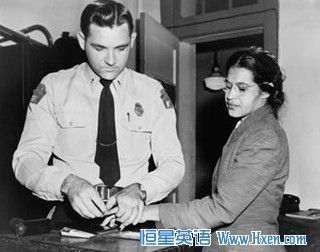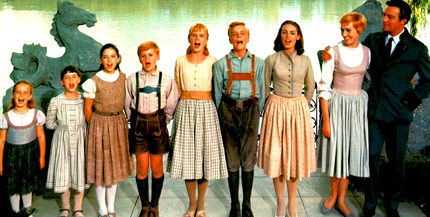参考译文:
罗莎.帕克斯(1913-2005):美国民权运动之母
今天,我们向你介绍被人尊称为美国民权运动之母的罗莎.帕克斯。
一直到二十世纪六十年代以前,黑人在美国的许多领域都无法享受到与白人一样的权利,美国南方一些州的法律仍然实行各族隔离,这些法律迫使黑人上单独的学校、居住在城市某个单独的区域,就是乘坐公共汽车,也只能坐在单独的区域。1955年12月1日,在美国南部的阿拉巴马州蒙哥马利市,一位42岁的黑人妇女乘坐公共汽车,当时法律要求黑人只能坐在白人让他们坐的位置上,这位妇女拒绝这么做,于是她被捕了。蒙哥马利市的这一和平不服从行为开启了黑人抗议大幕,它导致美国少数民族权利的合法转变。开启美国民权运动这一大幕的妇女就是罗莎.帕克斯。今天,我们就向你讲述她的故事。
1913年,罗莎.帕克斯出生于阿拉巴马州Tuskegee的罗莎.路易丝.麦克利家,她11岁时才在当地的学校上学,之后,她被送到蒙哥马利市上学。为了照顾她病中的奶奶,她高中时退学,随后她又照顾她的母亲。她一直到21岁时,才完成高中的学业。1932年,她与雷蒙德.帕克斯结婚,雷蒙德是一位理发师,他还是一位民权活动家。结婚后,他们共同为美国有色人种发展联合会在当地的机构工作。在1943年,帕克斯太太成为该组织的一名官员,后来又成为该组织的一名领导人。罗莎.帕克斯是蒙哥马利市的一名缝纫师,她从二十世纪三十年代一直到1955年一直做裁缝,后来,她成为无数非裔美国人追求自由的代表。
二十世纪五十年代,在美国南方的许多地区,城市公交车前几排坐位都只能由白人来坐,黑人一般坐在后面,而在中间,白人与黑人都可以坐,但当黑人坐在中间,如果白人想要坐人话,黑人就得将坐位让给白人。
罗莎.帕克斯和其他三个黑人坐在中间,此时有一个白人上了公交车,想要一个坐位。司机命令所有的黑人都离开他们的坐位,这样白人就可以不必与他们中的任何一个黑人坐在一起了。这三个黑人站了起来,但帕克斯太太拒绝了,于是她被捕了。在关于此事件的一些流传的说法中,有一个说法是,帕克斯太太之所以拒绝让坐,是因为她的脚实在是太累。但几年后她自己说,那个说法是错误的。她说,她真正感到厌倦的是接受不平等的待遇。她后来解释说,这里似乎就是她要停止那种令人摆布、追求她应有的人权的地方。
蒙哥马利的一个黑人妇女活动组织是著名的一个妇女政治理事会,这个组织正在努力反对黑人在公交车上所受到的不公平待遇。黑人由于冒犯公交司机的命令而经常被捕,甚至被杀。罗莎.帕克斯不是第一个拒绝将自己的坐位让给白人的黑人,但蒙哥马利的黑人组织认为她成为那些抗议者中的有权利的公民,因为她是该城市中最优秀的一位公民。这个妇女组织立即呼吁蒙哥马利市的所有黑人在帕克斯太太受审的那天拒绝乘坐公交车,这一天是12月5日,星期一。其结果,这一天,有四万人步行或使用其他的交通工具。那天晚上,全城举行集会,蒙哥马利市的黑人同意继续联合抵制乘坐市公交车,一直到他们所受的不平等待遇结束为止。他们还要求市政官员雇用黑人司机,而且任何人都可以坐在公交车的中间,而不必给他人让坐。
蒙哥马利市联合抵制公交车行动一直持续了381天,这一行动是由当地黑人领导人尼克松和一名年轻黑人部长马丁.路德.金领导的。类似的抗议活动在其他南方城市相继出现。最后,美国最高法院对帕克斯太太的案件作出裁决,该裁决城市公交车上实施种族隔离为非法。这一裁决于1956年11月13日作出,几乎是帕克斯太太被捕的一年之后。蒙哥马利市的联合抵制乘坐公交车的行动于该裁决到达的当天,即1956年12月20日结束。罗莎.帕克斯和马丁.路德.金在美国南方开始了非暴力抗议运动,这一非暴力抗议运动永远改变了美国的民权状况。马丁.路德.金成为该运动著名的演说家,但他没能看到他所为之努力的成果,而罗莎.帕克斯看到了。
在联合抵制乘坐公交车后,罗莎.帕克斯和她家庭的生活越来越困难,她被解雇了,而且没能找到工作,所以,帕克斯一家离开蒙哥马利,他们搬到了维吉尼亚,后来又搬到了密歇根州的底特律。帕克斯太太在1965年以前一直做裁缝。后来,密歇根州国会代表JohnConyers给她提供了一份岗位――――在他位于底特律的国会办公室中工作,她从事此项工作一直到1988年退休为止。
纵观她的一生,罗莎.帕克斯一直为全国有色人种发展联合会(NAACP)工作,并参与了各种民权活动。她是一位宁静的女性,这似乎与她的名声不怎么相符。但她说,她想帮助别人,特别是想帮助年轻人,让他们自己而更好地生活,同时也帮助他人。在1987年,她成立了罗莎-雷蒙德.帕克斯自我发展协会,以帮助改善黑人儿童的生活状况。
罗莎.帕克斯由于她在民权运动的杰出贡献而获得两项国家最高荣誉。在1996年,克林顿总统授予她总统自由勋章,在1999年,她又获得了国会授予的金质勋章。
在她晚年,人们经常问罗莎.帕克斯,当民权法律在二十世纪六十年代得到通过后,种族之间的关系得到了多少改善,她认为消除种族之间的隔阂还有很长的路要走,她仍然关注美国的种族平等运动。罗莎.帕克斯于2005年10月24日逝世,享年92岁。她的遗体被安放在华盛顿的美国国会大厦,她是第一位获此荣誉的美国女性。三万多人静静地向她的遗体告别,以显示他们对她的敬仰。Conyers众议员谈到,这位女性平静的力量对美国意味着什么,他说:“在美国,只有少数几个人敢说,他们的行为改变了美国的形象,罗莎.帕克斯就是其中之一。”
罗莎.帕克斯影响了许多美国人。在密歇根州的底特律,有四千人出席了她的葬礼,在这些人中,有美国前总统比尔.克林顿及其夫人希拉里.克林顿参议员,有耶西.杰克逊牧师,还有全国伊斯兰领导人路易斯.法拉可汗。克林顿总统回忆起他小时候美国南方公交车上所实行的种族隔离,他说,罗莎.帕克斯促进了所有美国人的自由,他说,全世界都知道她,因为她一个人的勇敢行为触动了人们对种族仇恨那麻木不仁的神经。
美国参议院宗教事务官员俄利耶在华盛顿的一次纪念仪式上谈到她时说:罗莎.帕克斯的勇敢行为是小事却带来巨大力量的范例。耶西.杰克逊牧师对她那微小的勇敢行为对非裔美国人意味着什么时说:1955年发生在公交车上的那件小事,“她坐在位子上,而我们也许还站着,…她开启了漫长的通向自由之门。”
简评:
有关美国民权运动,我在翻译中,已经谈到多次,在此不作更多的评论。在此文中,我注意到一个细节,那就是发生在蒙哥马利市的黑人抵制公交车行动,竟然持续了381天(文中就是这么说的),这让我不得不对黑人深表敬意。

一项抗议活动,而且是全市性的抗议活动,如果能够坚持一周,一个月,那就已经很了不起了,如果能够坚持半年,那么,可以说没有什么事是做不到的。然而,这些黑人,在那个年代,坚持了一周、一个月、半年,虽然没有结果,但他们并没有气馁,仍然继续坚持,一直到胜利为止,这种集体性的坚韧,让我不得不佩服。
我们都说,什么事,就怕坚持,如果真的能够坚持,那么,真的是世上无难事了。然而,我们日常生活中,最难做到的恰恰是“坚持”二字。一个人,还好说,能够坚持一年、二年、三年,以至更长时间,但让一个集体坚持那么长时间,那几乎是不可能的。美国的黑人做到了,他们为了能够给罗莎.帕克斯讨回公道,硬是坚持到底,真正做到了不达目的,誓不罢休。一个集体、一个民族,如果能够有这样的精神,那么还有什么事是做不到的。奥巴马当选美国总统,自然也就是情理之中了。
不要轻易地给自己找借口,没有什么是不可克服的。看准目标,坚持吧,坚持到底,就可能胜利,如果不坚持,此前的努力,将付之东流。
Rosa Parks, 1913-2005: Mother of theAmerican Civil Rights Movement
Today, we tell about RosaParks, who has been called the mother of the American civil rightsmovement.
Rosa Parks |
Until the nineteen sixties, black people in manyparts of the United States did not have the same civil rights aswhite people. Laws in the American South kept the two racesseparate. These laws forced black people to attend separateschools, live in separate areas of a city and sit in separate areason a bus. On December first, nineteen fifty-five, in the southerncity of Montgomery, Alabama, a forty-two year old black woman goton a city bus. The law at that time required black people seated inone area of the bus to give up their seats to white people whowanted them. The woman refused to do this and was arrested. Thisact of peaceful disobedience started protests in Montgomery thatled to legal changes in minority rights in the United States. Thewoman who started it was Rosa Parks. Today, we tell her story.
She was born Rosa Louise McCauley innineteen-thirteen in Tuskegee, Alabama. She attended local schoolsuntil she was eleven years old. Then she was sent to school inMontgomery. She left high school early to care for her sickgrandmother, then to care for her mother. She didnot finish high school until she was twenty-one. Rosa marriedRaymond Parks in nineteen thirty-two. He was a barber who cut men'shair. He was also a civil rights activist. Together, they workedfor the local group of the National Association for the Advancementof Colored People. In nineteen forty-three, Missus Parks became anofficer in the group and later its youth leader. Rosa Parks was aseamstress in Montgomery. She worked sewing clothes from thenineteen thirties until nineteen fifty-five. Then she became arepresentation of freedom for millions of African-Americans.
In much of the American South in the nineteenfifties, the first rows of seats on city buses were for whitepeople only. Black people sat in the back of the bus. Both groupscould sit in a middle area. However, black people sitting in thatpart of the bus were expected to leave their seats if a whiteperson wanted to sit there.
Rosa Parks is fingerprinted after refusing tomove to the back of a bus. |
Rosa Parks and three other black people were seatedin the middle area of the bus when a white person got on the busand wanted a seat. The bus driver demanded that all four blackpeople leave their seats so the white person would not have to sitnext to any of them. The three other blacks got up, but MissusParks refused. She was arrested. Some popular stories about thatincident include the statement that Rosa Parks refused to leave herseat because her feet were tired. But she herself said in lateryears that this was false. What she was really tired of, she said,was accepting unequal treatment. She explainedlater that this seemed to be the place for her to stop being pushedaround and to find out what human rights she had, if any.
A group of black activist women in Montgomery wasknown as the Women's Political Council. The group was working tooppose the mistreatment of black bus passengers.Blacks had been arrested and even killed for violating orders frombus drivers. Rosa Parks was not the first black person to refuse togive up a seat on the bus for a white person. But black groups inMontgomery considered her to be the right citizen around whom tobuild a protest because she was one of the finest citizens of thecity. The women's group immediately called for all blacks in thecity to refuse to ride on city buses on the day of Missus Parks'strial, Monday, December fifth. The result was that forty thousandpeople walked and used other transportation on that day. Thatnight, at meetings throughout the city, blacks in Montgomery agreedto continue to boycott the city buses until their mistreatmentstopped. They also demanded that the city hire black bus driversand that anyone be permitted to sit in the middle of the bus andnot have to get up for anyone else.
Martin Luther King Jr. |
The Montgomery bus boycott continued for threehundred eighty-one days. It was led by local black leader E.D.Nixon and a young black minister, Martin Luther King, Junior.Similar protests were held in other southern cities. Finally, theSupreme Court of the United States ruled on Missus Parks's case. Itmade racial separation illegal on city buses. That decision came onNovember thirteenth, nineteen fifty-six, almost a year after MissusParks's arrest. The boycott in Montgomery ended the day after thecourt order arrived, December twentieth. Rosa Parks and MartinLuther King, Junior had started a movement of non-violent protestin the South. That movement changed civil rights in the UnitedStates forever. Martin Luther King became its famous spokesman, buthe did not live to see many of the results of his work. Rosa Parksdid.
Life became increasingly difficult for Rosa Parksand her family after the bus boycott.
Rosa Parks and President Clinton after hepresented her with the Presidential Medal of Freedom in1996 |
She was dismissed from her job and could not findanother. So the Parks family left Montgomery.They moved first to Virginia, then to Detroit, Michigan. MissusParks worked as a seamstress until nineteen sixty-five. Then,Michigan Representative John Conyers gave her a job working in hiscongressional office in Detroit. She retired from that job innineteen eighty-eight.
Through the years, Rosa Parks continued to work forthe NAACP and appeared at civil rights events. She was a quietwoman and often seemed uneasy with her fame. But she said that shewanted to help people, especially young people, to make usefullives for themselves and to helpothers.In nineteen eighty-seven, she founded the Rosa and Raymond ParksInstitute for Self-Development to improve the lives of blackchildren.
Rosa Parks received two of the nation's highesthonors for her civil rights activism. In nineteen ninety-six,President Clinton honored her with the Presidential Medal ofFreedom. And in nineteen ninety-nine, she received theCongressional Gold Medal of Honor.
In her later years, Rosa Parks was often asked howmuch relations between the races had improved since the civilrights laws were passed in the nineteen sixties. She thought therewas still a long way to go. Yet she remained the face of themovement for racial equality in the United States. Rosa Parks diedon October twenty-fourth, two thousand five. She was ninety-twoyears old. Her body lay in honor in the United States Capitolbuilding in Washington. She was the first American woman to be sohonored. Thirty thousand people walked silently past her body toshow their respect. Representative Conyers spoke about what thiswoman of quiet strength meant to the nation. He said: "There arevery few people who can say their actions and conduct changed theface of the nation. Rosa Parks is one of those individuals."
Rosa Parks meant a lot to many Americans. Fourthousand people attended her funeral in Detroit, Michigan. Amongthem were former President Bill Clinton, his wife Senator HillaryRodham Clinton, the Reverend Jesse Jackson, and Nation of Islamleader Louis Farrakhan. President Clinton spoke about rememberingthe separation of the races on buses in the South when he was aboy. He said that Rosa Parks helped to set all Americans free. Hesaid the world knows of her because of a single act of bravery thatstruck a deadly blow to racial hatred.
Earlier, the religious official of the UnitedStates Senate spoke about her at a memorial service in Washington.He said Rosa Parks's bravery serves as an example of the power ofsmall acts. And the Reverend Jesse Jackson commented in a statementabout what her small act of bravery meant for African-Americanpeople. He said that on that bus in nineteenfifty-five, "She sat down in order that we might stand up… and sheopened the doors on the long journey to freedom."
http://www.21voa.com/path.asp?url=/200903/se-pia-rosa-parks-08-mar-09_0.Mp3
 爱华网
爱华网

